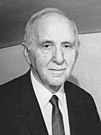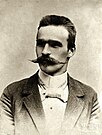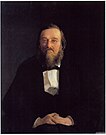National University of Kharkiv
This article needs additional citations for verification. (February 2020) |
Харківський національний університет імені В. Н. Каразіна | |
 | |
| Latin: Universitas Charcoviensis[1][2] | |
Former names | Imperial Kharkov University (1804—1917) Free Academy of Theoretical Knowledge (1920—1921) Kharkiv Institute of Public Education (1920—1932) Kharkiv State University (1932—1999) |
|---|---|
| Motto | Cognoscere, Docere, Erudire (Latin) |
Motto in English | To learn, To Educate, To Enlighten |
| Type | National university |
| Established | 29 January 1804 |
| Rector | Tetyana Kahanovska |
Academic staff | 2,256 |
| Students | 17,368 |
| Postgraduates | 500 |
| Address | 4, Svobody square, 61022 , , , |
| Campus | Urban |
| Colors | Blue & White |
| Affiliations | IAU, EUA, WHO |
| Website | karazin.ua |
Building details | |
Головний корпус Харківського університету | |
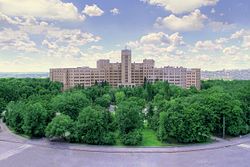 | |
 | |
| General information | |
| Location | Kharkiv, Ukraine |
| Completed | 1932 |
Kharkiv University or Karazin University[3] (Ukrainian: Каразінський університет), officially V. N. Karazin Kharkiv National University (Ukrainian: Харківський національний університет імені В. Н. Каразіна), is a public university in Kharkiv, Ukraine. It was founded in 1804 through the efforts of Vasily Karazin becoming the second oldest university in modern-day Ukraine.
During the Russian invasion of Ukraine, all buildings were partially or fully destroyed by attacks from Russian forces.[4][5]
History
[edit]Russian Empire
[edit]On 29 January [O.S. 17 January] 1805, the Decree on the Opening of the Imperial University in Kharkiv came into force. The university became the second university in the south of the Russian Empire. It was founded on the initiative of the local community with Vasily Karazin at the fore, whose idea was supported by the nobility and the local authorities. Count Seweryn Potocki was appointed the first supervisor of the university, the first rector being the philologist and philosopher Ivan Rizhsky.
In 1811, the Philotechnical Society was founded, while the Mathematical Society of Kharkiv, the Historical and Philological Society of Kharkiv, the Naturalists Society, Societies of Physics, Chemistry, Law, among others, were established in the second half of the 19th century. The first periodicals in Slobozhanshchyna appear in the university around this time, including Kharkovski Ezhenedelnik (1812), Ukrainski Vestnik (1816–1819), Ukrainski Zhurnal (1824–1825), etc.
In 1839, a veterinary school, which in 1851 became an independent institute, was established at the university. By this time, the campus included laboratories, clinics, an astronomical observatory, a botanical garden and a library.
Previously, the university was autonomous with rectors being elected. However, from 1820 to 1850, all its activity was strictly controlled. Rectors were appointed by the Minister of Education, while scientific publications, and academic processes were censored.
In 1863, under a new Statute,[which?] the university became partly autonomous.
The university has been publishing Scientific Notes since 1874.
From the 19th century up to the early 20th century, the University of Kharkiv had four schools: School of Physics and Mathematics, School of History and Philology, School of Medicine, School of Law.
The university exerted great influence on school-life in Slobozhanshchyna in the first period of its existence, largely from 1805 to 1835.[citation needed]
Ukrainian SSR
[edit]From 1917 to 1920, there was a struggle between advocates of the Ukrainian statehood and Russian course. Some of the professors who opposed new political realities left. Most of the Ukrainian professors remained in Kharkiv. They continued working in the institutions founded by the Soviet government: the Academy of Theoretical Knowledge (1920–1921), Kharkiv Institute of Public Education (KhIPE, 1921–1930), Kharkiv Institute of National Economy, Institute of Physics and Chemistry, and Institute of Law. Kharkiv State University, consisting of seven schools — School of Physics and Mathematics, School of Chemistry, School of Biology, School of Geology and Geography, School of Literature and Linguistics (with Department of Philosophy), and School of Economy (with Department of Economic Geography) — was restored on their basis in 1932–1933.
In 1921, Kharkiv Medical Institute was founded based on the School of Medicine of the University of Kharkiv.[citation needed]
In 1936, the university was named after the late Russian writer Maxim Gorky (though he was not related to the university during his life). During the German-Soviet war, it was evacuated to the city of Kizilord in Kazakhstan, where it merged with the Kyiv University to form the United Ukrainian State University.[6] In 1943/44, the university returned to Kharkiv (the first academic year after the liberation of the city on 1 November 1943). In 1951, 800 university students suffered from persecution after they refused to pass exams in Russian. Court trials were held behind closed doors.[citation needed]
In 1977, the following schools were operating in the university: School of Mechanics and Mathematics, School of Physics, School of Geology and Geography, School of Economy, School of History, School of Philology, School of Foreign Languages, School of General Sciences, School of Correspondence Learning, and Night School.[citation needed]
Independent Ukraine
[edit]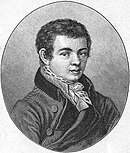
On 11 October 1999, Leonid Kuchma, the President of Ukraine issued a decree, in which he, "taking into consideration considerable contribution that Kharkiv State University made to training qualified specialists and to development of science" granted the status of a national university and named it after its founder, Vasyl Karazin.[citation needed]
In 2004, the university was given a twin building (the former Govorov Academy), opposite Svobody Square.[citation needed]
Russian shelling hit the building of the Faculty of Economics[7] which was subsequently destroyed by further Russian shelling.[8] On 5 March the university sports complex was partially destroyed. On 11 March — the building of the Faculty of Physics and Technology was partially destroyed and on 18 March — the Institute of Public Administration was partially ruined. As of 22 March 2022, according to the university's press service, the university had no intact buildings left.
Campuses and buildings
[edit]- Main building
- Northern building
- Central Scientific Library
- Students’ Campus
Ranking
[edit]| University rankings | |
|---|---|
| Global – Overall | |
| THE World[9] | 477 (2021) |
Under the Soviet Union, the University of Kharkiv was decorated the Order of the Red Banner of Labour, the Order of the October Revolution and the Order of Peoples' Friendship.[citation needed]
| University rankings | |
|---|---|
| Regional – Overall | |
| QS Emerging Europe and Central Asia[10] | 23 (2024) |
Kharkiv National University holds the second place in Ukraine in volume of publications and citations in scientific database Scopus and the Hirsch index, with the best academic results in the School of Medicine and School of Biology.
In 2017, according to QS World Univeristy Rankings, it is the best university in Ukraine and ranks as 382th university in the world. Also, in 2021, according to THE World University Rankings,[11] it is the best university in Ukraine and ranks as 477th university in the world.
Units
[edit]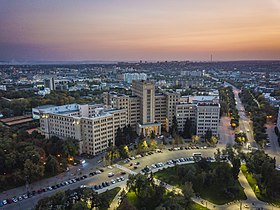
Departments
[edit]- School of Biology
- School of Chemistry
- School of Computer Sciences
- School of Ecology
- School of Economics
- School of International Economic Relations and Tourism
- School of Foreign Languages
- School of Medicine
- School of Geology, Geography, Recreation and Tourism
- School of History
- School Mechanics and Mathematics
- School of Law
- School of Physics
- School of Philology
- School of Philosophy
- School of Psychology
- School of Radiophysics
- School of Sociology
- Education and Research Institute of Ecology
- Education and Research Institute "Karazin Banking Institute"
- Education and Research Institute "Institute of Public Administration"
- Education and Research Institute "Karazin Business School"
- Institute of International Education for Study and Research
- Ukrainian Engineering Pedagogics Academy
Institute of High Technologies
[edit]- School of Physics and Technology
- School of Computer Science
- School of Energy Physics
Scientific institutions
[edit]- Kharkiv University History Museum
- State Natural History Museum of National University of Kharkiv
- The Museum of Archaeology
- The Museum of Astronomy (Hosted by the Institute of Astronomy)
Notable alumni and professors
[edit]- Notable alumni of Kharkiv University
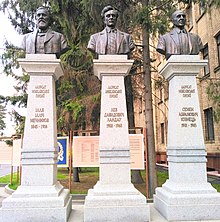
Nobel Prize winners
[edit]- Élie Metchnikoff (Medicine, 1908)
- Lev Landau (Physics, 1962)
- Simon Kuznets[12][13][14][15][16][17] (Economic Sciences, 1971)
Others
[edit]- Józef Piłsudski, Chief of State of Poland, first Marshal of Poland
- Boris Gourevitch, author, activist
- Roza Sarkisyan, theatre director
- Sergiy Vilkomir, computer scientist
- Marta Fiedina, synchro swimmer
- Maria Burmaka, singer, musician
- Anton Korobov, chess Grandmaster
- Petr Shatilov, physician
Rectors
[edit]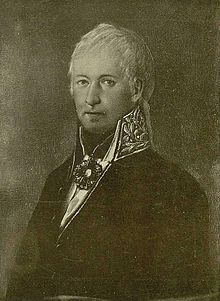
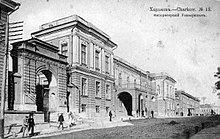
- 1805—1806, 1808—1811 Ivan Rizhsky
- 1807—1808, 1811—1813 Atanasije Stojković
- 1813—1820 Timofei Osipovsky
- 1821—1826 Vasily Dzhunkovsky
- 1826—1829, 1833—1836 Johan Christian Kroneberg
- 1829—1830 Andrej Dudrovich
- 1830—1833 Nikolai Yellinsky
- 1836—1837 Vasily Komlishinsky
- 1837—1838 Andrey Pavlovsky
- 1839—1841, 1849—1850, 1852—1853 Alexey Kunitsyn
- 1841—1849 Petro Hulak-Artemovskyi
- 1850—1852, 1872—1873 Alexander Paliumbetsky
- 1853—1859 Karl Voigt
- 1859—1862 Alexander Roslavsky-Petrovsky
- 1862—1872 Vladimir Kochetov
- 1873—1881 Adolphe Pitra
- 1881—1884 Grigory Tsekhanovetsky
- 1884—1890 Ivan Shchelkov
- 1890—1899 Mikhail Alekseyenko
- 1899—1901 Herman Lagermarck
- 1901—1905 Nikolay Kuplevasky
- 1905—1906 Ludwig Reinhard
- 1906—1911 Dmytro Bahalii
- 1912—1918 Ivan Netushil
- 1918—1919 Porfiry Pyatnitsky
- 1919—1920 Vladimir Levitsky
- 1920—1922 Anthony-Boniface Psheborskyi
- 1922—1924 Semen Strelbytskyi
- 1924—1930 Myroslav Gavrylov
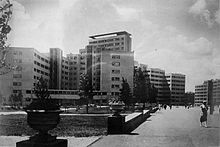
Constructivist House of Projects, 1930s before the university moved to it. - 1930—1934 Yakov Bludov
- 1934—1937 Oleksiy Neforosny
- 1937—1938 Lazar Gurevich
- 1938—1941 Oleksandr Sazonov
- 1941—1942 Andriy Zhelehovskyi
- 1942—1943 Mykhailo Vetukhov
- 1943 Oleksiy Rusko
- 1943—1945 Nikolai Barabashov
- 1945—1960 Ivan Bulankin
- 1960—1966 Volodymyr Lavrushyn
- 1966—1975 Volodymyr Hotkevich
- 1975—1993 Ivan Tarapov
- 1993—1998 Svich Vasyl
- 1998—2021 Vil Bakirov
- 2021—present Tatyana Kaganovska
See also
[edit]References
[edit]- ^ Record of the Jubilee Celebrations of the University of Sydney. Sydney, New South Wales: William Brooks and Co. 1903. ISBN 9781112213304.
- ^ Anderson, Peter John (1907). Record of the Celebration of the Quatercentenary of the University of Aberdeen: From 25th to 28th September, 1906. Aberdeen, United Kingdom: Aberdeen University Press (University of Aberdeen). ASIN B001PK7B5G. ISBN 9781363625079.
- ^ "Modern university". Karazin University. Archived from the original on 20 October 2020. Retrieved 14 July 2017.
- ^ "25 меценатов сделали пожертвования на восстановление Харьковского университета", Объектив (22 March 2022)
- ^ "Russians have completely destroyed Karazin University in Kharkiv", Chytomo (3 April 2022)
- ^ "KNU-history - Open University of Taras Shevchenko National University of Kyiv". knu.edu.eu. Retrieved 17 May 2022.
- ^ Sistek, Scott (25 March 2022). "Massive icicles hang from destroyed Ukrainian school amid nearly week-long freeze". FOX Weather. Retrieved 18 April 2022.
- ^ McCann, Allison; Gamio, Lazaro; Lu, Denise; Robles, Pablo (17 March 2022). "Russia Is Destroying Kharkiv". The New York Times. ISSN 0362-4331. Retrieved 18 April 2022.
- ^ "World University Rankings". 20 August 2019.
- ^ "V. N. Karazin Kharkiv National University". Top Universities. Retrieved 4 March 2024.
- ^ "World University Rankings 2021". Retrieved 12 June 2021.
- ^ Goldthwaite, Richard; Abramovitz M. (1986). "Association Notes: In Memoriam: Frederic C. Lane 1900-1984, Simon Kuznets 1901-1985". The Journal of Economic History. 46 (1): 239–246. doi:10.1017/S0022050700045630. JSTOR 2121281.
- ^ Weyl, E. Glen (2007). "Simon Kuznets: Cautious Empiricist of the Eastern European Jewish Diaspora" (PDF). Harvard University Society of Fellows; Toulouse School of Economics. p. 8. Archived from the original (PDF) on 17 October 2013. Retrieved 4 February 2012.
- ^ University of Kharkiv. "Historical background". Retrieved 10 April 2014.
- ^ Perlman, Mark (2001). "Schumpeter and Schools of Economic Thoughts". In Chaloupek, Günther; Guger, Alois; Nowotny, Ewald; Schwödiauer, Gerhard (eds.). Ökonomie in Theorie und Praxis: Festschrift für Helmut Frisch (in German and English) (German ed.). Springer. p. 286. ISBN 3540422404.
- ^ Pressman, Steven (2006). Fifty Major Economists. Routledge. p. 181. ISBN 0415366488.
Simon Kuznets university Kharkov.
- ^ Simon, Kuznetz (2011). Weyl, E. Glen; Lo, Stephanie H. (eds.). Jewish Economies: Development and Migration in America and Beyond. Vol. I. Transaction Publishers. p. xix. ISBN 978-1412842112.
External links
[edit]- Official Website (in English, Ukrainian, French, and Arabic)
- University of Kharkiv at Encyclopedia of Ukraine
- University Library Archived 2011-02-24 at the Wayback Machine (in English, Ukrainian, and Russian)



